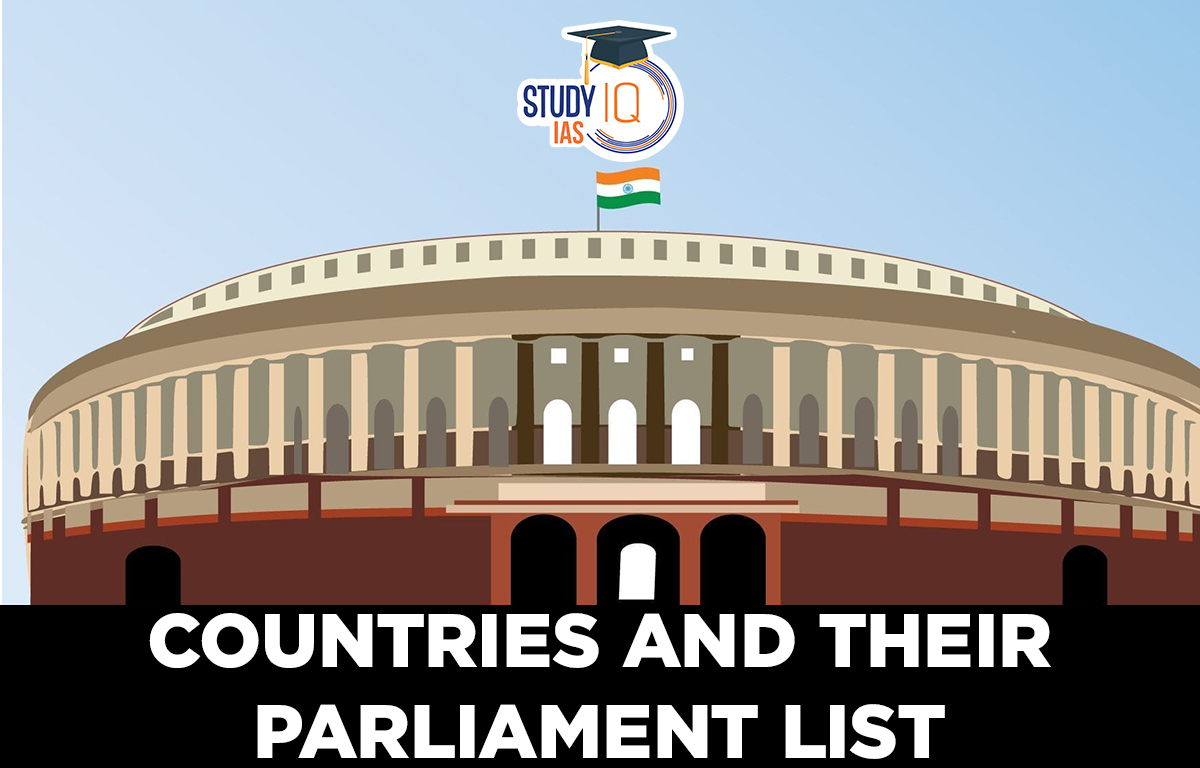Table of Contents
Countries and their Parliament List
The Althing is the world’s oldest surviving parliament. It is Iceland’s parliament, which was founded in 930 and still exists today. The Countries and their Parliament List is an important topic for competitive exams. Aspirants for various government exams should keep up to date with the list of countries and their legislatures provided in the article, as they may encounter questions about it in the General awareness sections.
In the prelims, UPSC aspirants may be asked questions about countries and their legislatures. We have compiled a list of countries and their legislatures in this article below.
What is Parliament?
A parliament is a governmental legislative body that represents the electorate, makes laws, and oversees the government through hearings and inquiries. The term Parliament is Anglo-Norman in origin and dates back to the 14th century. A legislature is divided into two chambers: Unicameral and Bicameral. India’s legislature is divided into two houses, the Lok Sabha and the Rajya Sabha.
List of Countries and their Parliament Names
The following is a list of Countries and their Parliaments. Candidates can read the table to prepare for their exams.
| Countries | Parliament of different Countries |
| Afghanistan | Shora |
| Albania | People’s Assembly |
| Algeria | National People’s Assembly |
| Andorra | General Council |
| Angola | National People’s Assembly |
| Argentina | National Congress |
| Australia | Federal Parliament |
| Austria | National Assembly |
| Azerbaijan | Melli Majlis |
| Bahamas | General Assembly |
| Bahrain | Consultative Council |
| Bangladesh | Jatia Parliament |
| Belize | National Assembly |
| Bhutan | Tsogdu |
| Bolivia | National Congress |
| Botswana | National Assembly |
| Brazil | National Congress |
| Britain | Parliament (House of Commons And House of Lords) |
| Brunei | National Assembly |
| Bulgaria | Narodno Sobranie |
| Cambodia | National Assembly |
| Canada | Parliament |
| China | National People’s Assembly |
| Colombia | Congress |
| Comoros | Legislative Council And Senate |
| Congo Democratic | Rep. of the National Legislative Council |
| Costa Rice | Legislative Council And Senate |
| Crotia | Sabor |
| Cuba | National Assembly Of People’s Power |
| Denmark | Folketing |
| East Timor | Constituent Assembly |
| Ecuador | National Congress |
| Egypt | People’s Assembly |
| El Salvador | Legislative Assembly |
| Ethiopia | Federal Council And House Of Representative |
| Fiji Islands | Senate & House Of Representative |
| Finland | Eduskusta (Parliament) |
| France | National Assembly |
| Germany | Bundestag (Lower House) & Bundesrat (Upper House) |
| Great Britain | Parliament |
| Greece | Chamber Of Deputies |
| Guyana | National Assembly |
| Hungary | National Assembly |
| Iceland | Althing |
| India | Sansad |
| Indonesia | People’s Consultative Assembly |
| Iran | Majlis |
| Iraq | National Assembly |
| Ireland | Oireachtas |
| Israel | The Knesset |
| Italy | Chamber Of Deputies And Senate |
| Japan | Diet |
| Jordan | National Assembly |
| Korea(North) | Supreme People’s Assembly |
| Korea(South) | National Assembly |
| Kuwait | National Assembly |
| Labanon | National Assembly |
| Laos | People’s Supreme Assembly |
| Lativa | Saeima |
| Lesotho | National Assembly And Senate |
| Libya | General People’s Congress |
| Lithuania | Seimas |
| Luxembourg | Chamber Of Deputies |
| Madagascar | National People’s Assembly |
| Magnolia | Khural |
| Malaysia | Majilis |
| Maldives | Majilis |
| Mongolia | Great People’s Khural |
| Montenegro | Federal Assembly |
| Mozambique | People’s Assembly |
| Myanmar | Pyithu Hluttaw |
| Nepal | Federal Parliament of Nepal |
| Netherlands | States-General (Staten-General) |
| New Zealand | Parliament (House Of Representatives) |
| Norway | Storting |
| Oman | Monarchy |
| Pakistan | National Assembly & Senate |
| Papua New Guinea | National Parliament |
| Paraguay | Senate & Chamber Of Deputies |
| Philippines | The Congress |
| Poland | Sejm |
| Romania | Great National Assembly |
| Russia | Duma & Federal Council |
| Saudi Arabia | Majlis Al Shura |
| South Africa | Parliament |
| Spain | Crotes |
| Taiwan | Yuan |
| Turkey | Grand National Assembly |
| Uruguay | General Assembly |
| USA | Congress |
| Uzbekistan | Oliy Majlis |
| Vietnam | National Assembly |
| Zambia | National Assembly |
| Zimbabwe | Parliament |
Parliament of India
The Indian Parliament is made up of two houses, the Rajya Sabha and Lok Sabha, as well as the President of India. It is also known as the People’s House because it represents Indians. Despite the fact that he is not a member of either house, the President is an important member of Parliament. As a result, the President has been assigned specific duties and responsibilities. The Constitution of India allows for a maximum of 552 members in the House (Initially, in 1950, it was 500). The house currently has 543 seats, which are filled by the election of up to 543 elected members.
The Rajya Sabha
The Rajya Sabha, or Upper House of Parliament, is a permanent body and is not subject to dissolution. However, one-third of the members retire every second year and are replaced by newly elected members. Each member is elected for a term of six years. The Vice President of India is the ex-officio Chairman of the Rajya Sabha. The Rajya Sabha can have a maximum of 250 members. The remaining members are chosen after the President nominates 12 members based on their achievements in literature, art, science, and social service. It now has a total of 245 members.
The Lok Sabha
The Lok Sabha, unlike the Rajya Sabha, is not a bicameral legislature. It is democratically elected by the public based on the ideology of universal adult franchises. It is also referred to as the lower House. The Lok Sabha has 550 members, 530 of whom are directly elected from the states and 20 from the UTs. Between 1952 and 2020, two seats in the Lok Sabha, India’s lower house of parliament, were reserved for members of the Anglo-Indian community. On the advice of the Government of India, the President of India nominated these two members.
The reservation of seats for Anglo-Indians in the Lok Sabha and State Legislative Assemblies was abolished by the 104th Constitutional Amendment Act. Through the 95th Amendment, 2009, the reservation for the Anglo-Indian community was extended until the year 2020. This provision was supposed to be in effect until 1960.


 Daily Quiz 11 July 2025
Daily Quiz 11 July 2025
 Operation Baam: Baloch Separatist Group ...
Operation Baam: Baloch Separatist Group ...
 Article 326 and Electoral Roll Revision ...
Article 326 and Electoral Roll Revision ...





















